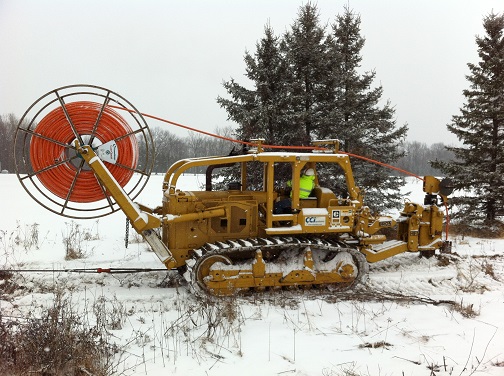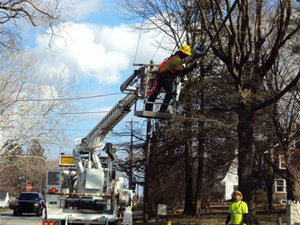NTIA Blog
Spotlight on NTIA: Suzanne Radell, senior policy adviser, Office of International Affairs
This post is part of our “Spotlight on NTIA” blog series, which is highlighting the work that NTIA employees are doing to advance NTIA’s mission of promoting broadband adoption, finding spectrum to meet the growing demand for wireless technologies, and ensuring the Internet remains an engine for innovation and economic growth.
 Suzanne Radell, a senior policy adviser in NTIA’s Office of International Affairs, spent far more of her childhood abroad than she did in the United States. It’s one reason why she says she was drawn to work on international issues when she grew up.
Suzanne Radell, a senior policy adviser in NTIA’s Office of International Affairs, spent far more of her childhood abroad than she did in the United States. It’s one reason why she says she was drawn to work on international issues when she grew up.
Radell, whose father worked as a civilian Army employee after serving in World War II, was born in Istanbul, Turkey and has lived in Belgium, France, Germany, Italy, Japan and Lebanon.
She got her undergrad degree in political science from Schiller College in Paris but decided to return to the United States to obtain a Master’s Degree in political science from the State University of New York, at Binghamton. She is a dissertation short of obtaining her doctorate in international relations from George Washington University.
Broadband Expanding Possibilities for Students in West Virginia and the Nation
For those of us who grew up in the 1960s and 1970s, dissecting a frog in middle school biology was a messy and smelly experience. Technology has made that a much cleaner experience in today's middle school biology classes – while also saving thousands of innocent frogs.
During a recent visit to Southside K-8 School in McDowell County, W.Va., I witnessed how technology allows students to dissect not just frogs online, but starfish and other amphibians as well. As a web-based program, this requires real bandwidth. Such activities would not have been possible last year when Southside was using two slower 3 Mbps-speed Internet connections for the whole school, which allowed for only a few students to work online at the same time.
With the help of a $126 million NTIA broadband grant, the school now has access to a fiber-based 100 Mbps connection that allows any Southside student to get online. NTIA’s grant has produced real results in this classroom in McDowell County and throughout West Virginia. It has helped bring a fiber broadband connection to all 750 public elementary and high schools in the state -- an important and proud milestone for West Virginia.
Bringing Broadband to Schools in Rural Michigan
President Obama’s ConnectED proposal aims to bring next-generation broadband, with speeds of at least 100 megabits per second and high-speed wireless, to K-12 schools across the nation.
Nowhere is the need greater – or the challenge tougher – than in rural America. High-speed Internet connections can give students living in remote communities access to classes, teachers and instructional materials that those in urban regions may take for granted. But with so many rural areas still lacking advanced telecommunications infrastructure, schools in these places often remain cut off from the promise of broadband.
In Michigan, a non-profit broadband provider called Merit Network is tackling this challenge by connecting K-12 districts in some of the most far-flung reaches of the state.

Merit, which owns and operates a statewide research and education network, dates back to the early academic and government networks that evolved into today’s Internet. It was established in 1966 by the University of Michigan, Michigan State University and Wayne State University.
New Broadband Map Data Shows Progress, But Work Remains
Two and a half years ago, the National Telecommunications and Information Administration (NTIA) launched an interactive online map that shows what high-speed Internet services are available to every neighborhood in the country.
This week, we are updating the dataset underlying the National Broadband Map (NBM) for the sixth time since it was established in early 2011 in collaboration with the Federal Communications Commission (FCC) and partners in every state and territory.
The new data – current as of Dec. 31, 2012 – reveals what types of technology and speeds are available from more than 2,000 telecommunications companies nationwide. And it confirms that we are making steady progress as a nation in ensuring that all Americans have access to at least a basic level of broadband.
As of the end of 2012, nearly 99 percent of Americans had access to broadband speeds of 3 Mbps downstream and 768 Kbps upstream through either wired or wireless service. And 96 percent had access to broadband speeds of 6 Mbps downstream and 1.5 Mbps upstream – speeds that will soon be considered a basic requirement for accessing many online services. Moreover, nearly 90 percent of Americans had access to 4G wireless broadband, defined as service with download speeds of at least 6 Mbps, as of the end of 2012. That’s up from 81 percent in June 2012 and just under 26 percent in June 2010.
Spotlight on NTIA: John Verdi, director of privacy initiatives, Office of Policy Analysis and Development
This post is part of our “Spotlight on NTIA” blog series, which is highlighting the work that NTIA employees are doing to advance NTIA’s mission of promoting broadband adoption, finding spectrum to meet the growing demand for wireless technologies, and ensuring the Internet remains an engine for innovation and economic growth.
 When NTIA was tasked last year with helping to launch a new multistakeholder process aimed at developing privacy codes of conduct for various business sectors, the agency turned to someone who understood how technology, law and privacy intersect.
When NTIA was tasked last year with helping to launch a new multistakeholder process aimed at developing privacy codes of conduct for various business sectors, the agency turned to someone who understood how technology, law and privacy intersect.
With a background as both a computer programmer and lawyer, John Verdi fit the bill. Verdi, who began his job as NTIA’s director of privacy initiatives in April 2012, has been in charge of organizing the multistakeholder process aimed at drafting voluntary industry codes of conduct to enhance consumer privacy. In this role, Verdi has the delicate job of trying to help move the process forward without weighing in on the substance.
The process reached an important milestone last week when stakeholders involved in the process agreed to begin testing and implementing a privacy code aimed at enhancing the transparency of mobile apps.
Building a Statewide Educational Network in the Keystone State
Late last month, I had the pleasure of joining representatives from the Keystone Initiative for Network Based Education and Research (KINBER) as they celebrated the completion of their statewide network linking many of the state’s colleges and universities. What had long been out of reach for Pennsylvania’s education community had finally become a reality with the help of NTIA’s broadband grant program.
Unlike most of its neighboring states, Pennsylvania did not have a statewide broadband network to serve the ever-expanding needs of educational institutions, healthcare centers, and other community institutions. That is until KINBER leveraged a $99.6 million grant from NTIA, along with $29 million in matching contributions, to build the Pennsylvania Research and Education Network (PennREN). The recently completed 1,600-mile statewide network currently provides affordable broadband service to customers, mostly colleges and universities, through 63 connection points on the network reaching 50 counties throughout Pennsylvania.

A KINBER construction crew strings fiber between telephone poles in a Pennsylvania community
(click to enlarge)
Connecting America’s Schools to Next-Generation Broadband
The White House recently set an ambitious goal to connect 99 percent of American students to ultra-fast broadband within five years. President Obama’s ConnectED initiative would bring Internet speeds of at least 100 megabits per second and high-speed wireless to K-12 schools across the nation.
At NTIA, we are already making these types of connections a reality in K-12 schools through our Broadband Technology Opportunities Program, which has invested about $4 billion in roughly 230 projects nationwide to expand broadband availability and use. Of our 116 network infrastructure projects, about 75 percent are linking or supplying additional bandwidth to schools. Overall, roughly 10,000 schools in 44 states are being connected or upgraded, and almost 70 percent are getting access to speeds of at least 100 megabits.
Thanks to our grant program, teachers, students and parents are witnessing how technology can transform education, expand student horizons and create new opportunities for those living in even the most remote corners of the country.
Spotlight on NTIA: Jim McConnaughey, Chief Economist
This post is part of our “Spotlight on NTIA” blog series, which is highlighting the work that NTIA employees are doing to advance NTIA’s mission of promoting broadband adoption, finding spectrum to meet the growing demand for wireless technologies, and ensuring the Internet remains an engine for innovation and economic growth.
 NTIA Chief Economist Jim McConnaughey is, as one would expect from an economist, passionate about economics and its use in public policy.
NTIA Chief Economist Jim McConnaughey is, as one would expect from an economist, passionate about economics and its use in public policy.
Yet, McConnaughey’s first job out of college as a junior-level economist at the Federal Communications Commission (FCC) was more serendipity than strategic career planning. McConnaughey said he sought a job at the Federal Trade Commission (FTC) but due to a misunderstanding was given a phone number to call about an opening at the FCC.
Mapping NTIA's Broadband Investments
To illustrate the impact of the $4 billion Recovery Act investment in the Broadband Technology Opportunities Program (BTOP) and State Broadband Initiative (SBI), NTIA has developed a user friendly online tool to visualize the high-speed broadband networks, public computer centers and Internet training programs funded across the country.
 The BTOP map went live in 2012 with data submitted by NTIA’s grantees in their 2011 progress reports. And we recently updated the map using data from last year’s progress reports.
The BTOP map went live in 2012 with data submitted by NTIA’s grantees in their 2011 progress reports. And we recently updated the map using data from last year’s progress reports.
As of the end of 2012, our projects had built or upgraded more than 86,000 miles of high-speed network infrastructure and connected more than 12,000 schools, libraries and other anchor institutions. They had installed more than 41,000 workstations in public computer centers, provided more than 12 million hours of computer and Internet training to more than 4 million people, and recorded more than 521,000 new residential broadband subscriptions.
Administration Advances Wireless Spectrum for Economic Growth
President Obama today issued a Presidential Memorandum that builds on the Administration’s commitment to make additional spectrum available for wireless broadband to drive innovation, expand consumer services, and increase job creation and economic growth. The memorandum establishes a set of measures that Federal agencies, in collaboration with industry and other stakeholders, will now take to more aggressively enhance spectrum efficiency and enable access to more spectrum for consumer services and applications.
Many of the new measures are common-sense ways to improve spectrum efficiency. Under the memorandum, an agency that requests a new spectrum assignment or that seeks to procure a spectrum-dependent system will have to document its consideration of alternative approaches and verify that it is pursuing the most spectrum-efficient method, in consideration of all relevant factors including cost and agency mission.
